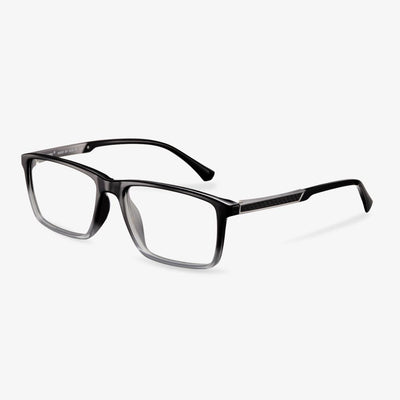Is there a standard for lens material selection?
No, again, according to your needs and budget. The materials of lens mainly include glass and resin, among which resin materials are divided into thermoplastic materials and thermosetting materials, respectively represented by PC and CR39. Different from the lens frame, the lens market choice is more uniform. And in recent years, resin lenses do better and better, most people choose thermosetting resin lenses.
What are prescription computer glasses?
Prescription computer glasses are prescription glasses designed to do computer work. They allow your eyes to focus on the computer screen, which is farther away than reading material would normally hold. These special glasses are designed to meet the visual needs of the movement.
Polarized vs non-polarized sunglasses
-
Non-polarized sunglasses generally only have the two basic functions of shielding strong light and filtering ultraviolet rays, and their efficiency in filtering ultraviolet rays is low. In our daily life, in addition to strong light and ultraviolet light, when light passes through uneven roads, water surfaces, and other places, irregular diffuse reflection light will be generated, which will cause blurred vision and fatigue in the eyes.
-
Polarized sunglasses can filter out this kind of light, only absorb the reflected light of the object itself, truly present what you see, make the field of vision clearer, and reduce visual fatigue. In addition, polarized sunglasses have a 99% blocking rate of ultraviolet rays due to their high-efficiency filter layer, which can effectively reduce the damage of ultraviolet rays to the eyes.
-
When judging whether the sunglasses are polarized lenses, you can rotate the sunglasses up to 45° clockwise. If the color of the lens changes at this time, and the color of the sunglasses returns to normal after turning the sunglasses back to the original position, then it can be judged that the sunglasses are polarized. And if you can’t see the change in the color of the sunglasses lens no matter how you turn it, then you can judge that the sunglasses are not polarized.
Driving Glasses - S MARCO
S MARCO professional driving glasses and S MARCO professional radiation glasses have become a new favorite family.S MARCO professional driving glasses have unique functions, opening a new page of driving glasses. The biggest advantage of S MARCO glasses is that it has its own patent in professional driving glasses, and the technology adopted is nano-polarized light technology. In addition, the driving glasses designed by the S MARCO team are based on Oriental faces, car conditions, and driving habits. With stylish style, they are comfortable to wear, functional and practical, very suitable for Chinese people to use.
Benefits of Saddle Bridge Glasses.
The most common type of plastic bridge is called a saddle bridge. The style is very comfortable because it distributes the weight of the glasses over a larger area rather than focusing on smaller points, like adjustable nose pads. Saddles are known to cost less to repair because they have fewer moving parts and are possible to maintain their fitness. There is now a new saddle bridge-type transparent silicone cushion for a screw-type nose pad. It is made of medical-grade soft silicone. It can be bent and is very soft. To fit the curve of the nose, a plastic frame with a saddle or keyhole bridge can slip off the nose without proper support. Silicone is a soft and elastic material that can be formed according to the contour and shape of the nose.
How do you clean an eyeglass case?
Sprinkle a little water on the glasses case first, to soften the dirt and dust on it. Brush gently with a soft brush to avoid damaging the glasses case. The inside of the case needs to be cleaned with a brush. Use a rag to wipe the surface of the glasses case for moisture and dirt. Wash it several times with a wet cloth. Use paper towels to dry the surface and interior. And then dry in the sun.
Progressive Lens
Standard progressive lenses are multifocal lenses with three observation areas, farsightedness, intermediate vision, and nearsightedness. Unlike bifocals, there are no visible lines between each viewing area. They have a seamless, invisible design, where the optical power changes 'gradually' throughout the lens. Many people confuse 'bifocal' or 'trifocal' with 'progressive' but remember that bifocals and trifocals have visible lines in the lens, while progressive lenses do not. Because progressive lenses have no lines in the lens, they are more popular multifocal lenses than bifocal lenses.
The main observation area of the progressive lens is a far distance, the smaller area at the bottom of the lens is used for myopia, and the middle area in the middle is smaller. Standard progressive glasses are very suitable for general purpose glasses, focusing on hyperopia activities (such as driving and walking) and sufficient area in the lenses for nearsighted activities (such as reading and computer use). The left and right sides or 'convex corners' of the lens are deliberately blurred to achieve an invisible design. The clearest line of sight in the gradual process is from the center to the top of the lens.











































